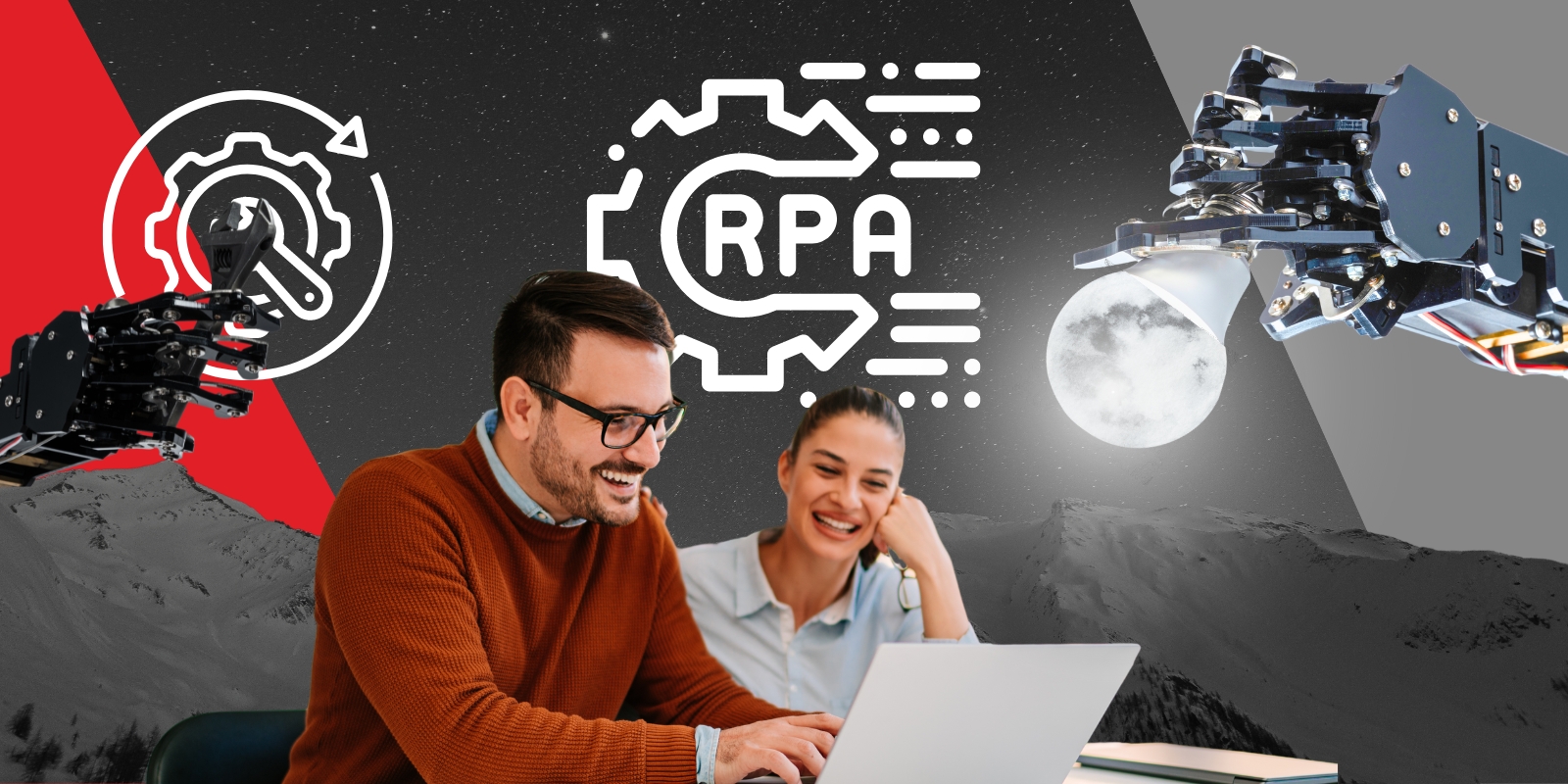Robotic Process Automation (RPA) represents a significant advancement in automation technology, focusing primarily on pre-programmed instructions that enhance business process agility. By automating repetitive tasks, it helps to boost professional productivity and streamline operations.
RPA enhances productivity by using software robots programmed to execute specific tasks, including data-driven activities and rule-based tasks. Implementing RPA tools within a business can significantly reduce human errors and improve efficiency to levels unattainable through manual efforts alone.
This article will explore the essential characteristics of this technology by defining it in simple terms and distinguishing it from general automation concepts in terms of scope and responsibilities. We’ll also examine its benefits and discuss strategies to overcome potential challenges.
|
What is RPA? Key features and use cases on RPA explained in simple terms
RPA is a desktop software designed to automate repetitive, or predictable tasks that are typically performed by humans. It utilizes software robots, or “bots”, which can emulate human actions to execute a sequence of steps, thereby completing significant activities without human intervention. RPA can be especially beneficial in automating business processes that require interaction with multiple digital systems.
Additionally, some RPA software provides low-code capabilities, allowing users to easily program bots to perform the necessary tasks for optimal performance.
Key characteristics
Before delving into the specifics, let’s first explore the key characteristics that underpin Robotic Process Automation (RPA):
- Automation of Repetitive Tasks: RPA bots can handle tasks like data entry, file manipulation, form filling, and repetitive administrative processes efficiently.
- Integration Across Diverse Systems: Bots can work across different software systems, making them ideal for tasks that require interacting with multiple applications, such as extracting data from one system and entering it into another.
- Rule-Based Decision Making: RPA follows predefined rules and logic, making it suitable for processes that don’t require human judgment or complex decision-making.
- Non-Invasive Technology: RPA doesn’t require significant changes to existing IT infrastructure. It can overlay on current systems, which makes it easier and more cost-effective to implement compared to other automation solutions.
RPA Use cases: When to Use RPA?
Below are just a handful of examples showcasing the transformative potential of RPA across various industries:
Finance and Accounting:
- Invoice Processing: Automating the extraction of data from invoices and entering it into accounting systems.
- Accounts Payable and Receivable: Automating the management of accounts payable and receivable, including processing payments and managing collections.
- Expense Management: Streamlining the processing of expense reports and reimbursements.
Human Resources:
- Employee Onboarding: Automating the process of setting up new employee profiles in various systems, enrolling in benefits, and other onboarding tasks.
- Payroll Processing: Automating the compilation of payroll data and ensuring accurate salary payments.
- Employee Data Management: Managing employee data changes, such as address updates or position changes, across various internal systems.
Customer Service:
- Automated Responses: Handling standard customer queries with automated responses.
- Contact Information Updates: Updating customer contact information across multiple platforms.
- Service Scheduling: Automating the scheduling of service appointments or follow-ups.
Healthcare:
- Patient Appointment Scheduling: Managing patient appointments and sending reminders.
- Medical Records Management: Updating and managing patient records across different systems.
- Billing and Claims Processing: Automating the processing of medical billing and insurance claims.
Retail and E-commerce:
- Order Processing: Automating the processing of orders, including updating inventory systems and initiating shipping processes.
- Returns Processing: Managing return requests and updating inventory and financial records accordingly.
- Customer Feedback Analysis: Collecting and processing customer feedback for analysis.
Supply Chain and Logistics:
- Inventory Management: Updating and managing inventory levels based on real-time data.
- Shipment Tracking and Coordination: Automating the tracking of shipments and updating systems with status and location information.
- Supplier Onboarding: Streamlining the process of onboarding new suppliers and managing their data.
IT Operations:
- Data Migration and Entry: Automating the migration of data between systems or regular data entry tasks.
- Network Monitoring: Monitoring network status and automatically flagging issues for review.
- User Account Management: Managing user accounts, including creation, updates, and deletion.
Banking:
- Loan Processing: Automating the initial stages of loan processing, such as data collection and initial assessment.
- Fraud Detection: Assisting in monitoring transactions for potential fraudulent activity.
- KYC Compliance: Automating the collection and verification of customer data for Know Your Customer (KYC) compliance.
Curious about learning more on how to improve your business efficiency regardless of your industry? The following article might interest you: Boomi Salesforce integration by industry: Healthcare, Financial Services and Retail
Does every RPA system low-code?
Not every Robotic Process Automation (RPA) software is necessarily low-code, but many RPA tools are designed with low-code or no-code principles. For instance, most low-code RPA software is specifically designed for citizen developers, who may not have any coding knowledge, or for developers who seek to avoid time-consuming, intricate logic programming. On the other hand, hard-coding options are more suitable when the desired outcome requires a high degree of customization flexibility. Additionally, there’s a third option: hybrid software that allows both low-code and hard-coding approaches to work in synchrony, offering the best of both worlds.
What’s the difference between RPA, Workflows and Process Automation?
Now that we have defined what exactly RPA is, you might be curious about what distinguishes it from other automation concepts like a general Workflow or Process Automation. While RPA is often considered an extension of Process Automation, it’s important to delineate each one to understand its unique functionalities that as heads up can be exemplified by a hierarchical order. In the following section, we’ll draw a line between these concepts to clarify the defining factors of each.
Robotic Process Automation (RPA)
- Scope: RPA is focused on automating specific tasks that are repetitive, rule-based, and typically involve interacting with digital systems. The scope is usually confined to individual tasks rather than end-to-end processes.
- Responsibilities: RPA bots are responsible for mimicking human actions like clicking, typing, and extracting data. They handle tasks such as data entry, file manipulation, or transferring data between systems.
- Level of Detail: RPA operates at a micro level, dealing with the automation of specific tasks. It involves detailed scripting of each step that a human would take to complete a task.
Workflow
- Scope: Workflows refer to the sequence and execution of business processes. They are broader than individual tasks, focusing on how different steps in a process are organized and how information or tasks flow from one stage to another.
- Responsibilities: Workflow management involves defining, executing, and automating business processes. It ensures that tasks, information, or documents are passed from one participant to another in the correct sequence and that the process rules are followed.
- Level of Detail: Workflows operate at an intermediate level, focusing on the sequence and coordination of tasks within a process. They involve detailing the flow and rules but do not necessarily automate the tasks themselves.
Process Automation
- Scope: Process Automation, or Business Process Automation (BPA), encompasses using technology to automate complex business processes. It’s broader than RPA, as it aims to automate end-to-end processes.
- Responsibilities: BPA is responsible for automating a sequence of activities or workflows to improve business efficiency. It involves integrating applications, restructuring labour resources, and using software applications throughout the organization.
- Level of Detail: BPA operates at a macro level, automating entire processes. It involves a high-level view of the business process and integrates various tasks and workflows into a cohesive automated process.
RPA vs. Workflows vs. Process Automation: Summary
Below is a summary table that clearly and concisely shows the differences between RPA, Workflows and Process Automation:
| Aspect | Robotic Process Automation (RPA) | Workflows | Process Automation |
| Scope | Automates specific, repetitive tasks. | Manages sequence and execution of business processes. | Automates end-to-end business processes. |
| Responsibilities | Mimics human actions for individual tasks like data entry. | Defines and ensures tasks flow in correct sequence and order. | Integrates and automates a series of tasks and workflows. |
| Level of Detail | Micro-level: Focuses on detailed scripting of individual tasks. | Meso-level: Focuses on the organization of tasks within processes. | Macro-level: Automates entire processes with a high-level view. |
Benefits of RPA
There are numerous benefits to using RPA software. For instance, since these bots operate independently without the need for human intervention once programmed, they can function continuously without breaks. Improving accuracy, cost savings, and enhancing productivity. Let’s explore these RPA benefits in depth to better understand them:
-
Increased Efficiency and Productivity
RPA bots can operate 24/7 without breaks, enabling much faster completion of tasks compared to manual processing. This increases overall productivity and allows human employees to focus on more complex tasks.
-
Cost Savings
By automating routine tasks, RPA reduces the labour costs associated with these tasks. Over time, this can translate into substantial cost savings for the organization.
-
Improved Accuracy
RPA reduces the likelihood of errors associated with human processing, such as data entry mistakes. This improved accuracy is crucial in areas where precision is essential, such as financial transactions and compliance reporting.
-
Enhanced Compliance
RPA can be programmed to follow regulatory requirements precisely, making it easier for businesses to maintain compliance with various legal and industry standards.
-
Better Customer Experience
By speeding up processes and ensuring accuracy, RPA can lead to faster customer service responses and higher satisfaction levels.
-
Employee Satisfaction
Automating mundane and repetitive tasks frees up employees to engage in more meaningful and rewarding work, which can improve job satisfaction and reduce burnout.
-
Business Agility
RPA enables businesses to adapt more quickly to market changes and operational demands, as bots can be reprogrammed to address new tasks or processes.
-
Insights and Analytics
RPA tools can collect data on task execution, which can be analyzed to gain insights into process efficiency, bottlenecks, and areas for improvement.
-
Reduced Operational Risk
By minimizing human intervention in routine processes, RPA reduces the risk of errors and inconsistencies in critical business operations.
Additionally, it’s not just RPA that shows significant benefits; overall automation implementation has been proven to yield a return on investment (ROI) more than double that of businesses opting for other alternatives. This finding is described by a McKinsey analysis, stressing the considerable financial advantages of choosing automation.

The benefits of RPA
Challenges of RPA
RPA technology is not infallible and can be limited by the quality of its programming. Bots follow predefined rules and logic, so they lack the ability to handle tasks that require human judgment, creativity, or complex decision-making. This means that RPA is not suitable for all types of tasks, and its effectiveness is only as good as the rules and processes it has been programmed to follow.
Additionally, scalability is another critical factor where this type of technology can encounter challenges. As more data is introduced, the bots may struggle to keep up with the commands, leading to errors and long execution times. This issue can often be directly attributed to the resources allocated for the software implementation. Outdated or unsuitable equipment can significantly impact the performance and efficiency of RPA systems.
Finally, there are concerns around security and privacy. As Robotic Process Automation bots handle and process sensitive data, there’s a risk of data breaches and leaks if the automation tools are not properly secured. Ensuring RPA solutions comply with data protection regulations and standards is crucial to avoid legal and reputational risks.
Are you looking for support or guidance implementing RPA in your organization? Contact us.
Overcoming the challenges of RPA with integration
There are several challenges to address when implementing RPA technology in a system. It’s essential to use the best equipment available to enhance the effectiveness of RPA. For instance, integration and robust cybersecurity measures like data encryption or Identity and Access Management (IAM) can significantly address scalability and security issues. Access to information from multiple systems within the business allows RPA to function quickly and efficiently, ensuring adherence to selected requirements. Furthermore, an effective cybersecurity plan that complies with data protection regulations is crucial to prevent data breaches.
However, as mentioned earlier, for RPA to handle large volumes of data requires more than just effective integration and a solid cybersecurity strategy. Regular maintenance is another key factor. Technologies like Boomi, Azure or Workato, which offer low-code capabilities, real-time monitoring, and an accessible interface, can simplify the process. Yet, a balance between automation and human skill, especially for maintenance and regular updates or audits of the bots, is vital for optimal implementation.
In this context, a team of experts like Chakray, known for dedicated strategic planning and technical solutions, is the perfect choice to elevate RPA implementations and reach new heights.
Conclusion
RPA enhances business productivity and increases ROI by automating tasks like data entry, thus freeing employees from time-consuming, repetitive tasks. This shift allows them to focus on more essential work that benefits overall business productivity. RPA also reduces human errors and can operate 24/7 without breaks. We’ve established that RPA operates on a micro-scale, focusing on specific day-to-day processes instead of mid- or large-scale automation.
We’ve discussed key challenges associated with RPA and how they can be overcome using iPaaS solutions like Boomi, Azure or Workato, cybersecurity strategies such as IAM technologies, and the essential human expertise required for system maintenance, audits, and updates.
At Chakray, our flexible and expert approach to solutions includes strategic planning and technical expertise to quickly respond to demanding situations requiring immediate attention or constant monitoring.
If you’re seeking a tailored automation implementation that covers IT architecture or operational efficiency, we are here to help you achieve your business goals. For support, feel free to contact us at any time!


Talk to our experts!
Contact our team and discover the cutting-edge technologies that will empower your business.
contact us




